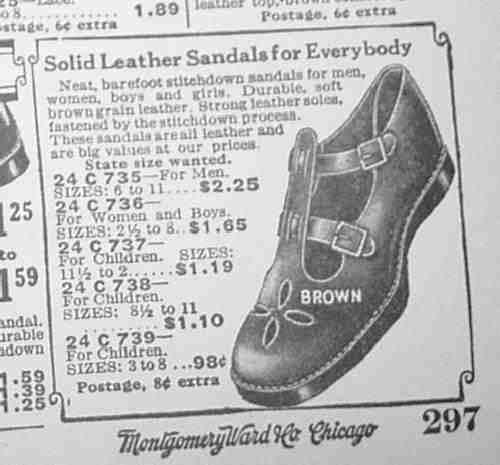
Figure 1.--Montgromery Ward was offering double bar sandals for adults and children in their 1922 catalog. It was only available in brown. Note flower design openings. |

|
There were two basic types closed-toe sandals, besides the single bar Mary Jane style. The first and most common style had a center strap. This style is commonly known as as school sandal in England and a "T" strap shoe in America. It was also referred to as a sand shoe. The other style of closed-toe sandal had double side bars with the center starp. I know it existed in the 1920s, but I'm not sure how much earlier. This style had double horizontal straps. British boys generally did not wear this style and in America in was mostly worn by girls.
We note a few portraits of boys at the turn-of-the-20th century wearing an early open style of sandal. The images suggest that the style appeared about 1900-10. We are not precisely sure about the chronology and do not yet have any catalog offeings for this style of sandal. We have very limited information on this style. Based on the photographic record, it does not appear to have been very popular. We see many more images of boys wearing different styles of closed-toe sandal.
The single bar strap shoe was a dress shoe untilthe 1910s or 20s when it began to be worn by younger children for play. It was at this time that colored versions of this clasic shoe fashion appeared. It was made famous as a play shoe by Christopher Robin on the Winnie the Poo books. Actually the real Christopher Robin (Christopher Milne) wore the school sandal style with the center strap.
The most common style of play sandal had a center strap. This style is commonly known as a school sandal in England and a "T" strap shoe or sandal in America. I believe that it was also referred to as a sand shoe in England, but an English reader disagrees with this. I am not sure when it first appeared. At this time we can only trace it to the 1910s. We note for example the Scottish Maxwell family wearing classic "T" strap sandals about 1917. They were a wealthy family. We do not know how common these sandals were for other British boys. They do not seem ,however, to have been widely worn until after World War I (1914-18) in the 1920s. It proved more popular for boys in England and Europe than in America. The NAZIs disapproved of it and it was not widely worn in Germany after the mid-1930s. We do begin to see it more more commonly after the War into the 1950s. Dress shoes for girls were ecentually made in this style.
The other major type of closed-toe sandal had double side bars with the center starp. I know it existed in the 1920s, but I'm not sure how much earlier. This style had double horizontal straps. It appeared in America as well as Britain, but proved more popular in Bitain. British boys, however, generally did not wear this style as most, but not all boys' school sandals had only one side strap. In America the double bar sandal was mostly worn by girls and has proven to be an enduring fashion classic. This style has remained a primarily a girl's play sandal and was not worn for dresswear. Some boys also wore these sandals. It was occasionaly seen in the Spring and worn for Easter or spring wear. Thecmost popular color for boys appears to have been white. Unlike the girls, this was for boys more of a dressy shoe style than a play sandal. It appears to have been more common in the South than the Northeastern states--normally the area in which boys dress fashions set trends.
Although not a common style, double bar sandals were made without center straps. HBC has noted this style in the 1910s. It appears to have been more of a dressy shoe style than a play sandal. They were mostly made in black patent leather. They were worn by boys and girls, but generally younger children. They were mostly worn with white long stockings.
Although not as common as the other type of closed-toe sandals, HBC has noted some with multiple straps which appear to extnd bove the ankle. They look like the boy is wearing stripped socks. The chronology of these multiple strap sanls, however is different than that of stripped socks which we note more in the 1870s and 80s. We note these multiple stripped sndals primarily in the early 1900s before World War I (1914-18). These sandals were worn by both boys and girls.
We note one style that is essentially a closed-toe sandal woth the tor-cut out a the tip. This was a very common style dor girls and women in the 1930s-50s, but we did not commonly see boys wearing them. One rare exception we have noted is a Kindergarten boy in 1955.
Navigate the Boys' Historical Clothing Web Site:
[Return to Main closed-toe sandal page]
[Introduction]
[Activities]
[Biographies]
[Chronology]
[Clothing styles]
[Countries]
[Bibliographies]
[Contributions]
[Essays]
[FAQs]
[Glossaries]
[Images]
[Links]
[Registration]
[Tools]
[Boys' Clothing Home]
